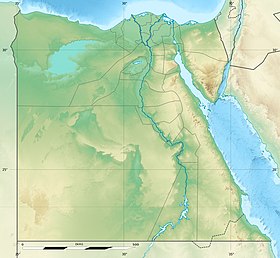Gebel Tjaouti
Le Gebel Tjaouti[1] est une formation rocheuse en Égypte. Le rocher est nommé d'après Tjaouti, un ancien fonctionnaire égyptien qui a vécu à la fin de la VIIIe dynastie.
| Gebel Tjaouti | ||
| Site d'Égypte antique | ||
|---|---|---|
| Localisation | ||
| Coordonnées | 25° 52′ 09″ nord, 32° 32′ 33″ est | |
| Géolocalisation sur la carte : Égypte
| ||
| modifier |
||
Le rocher est connu pour une série d'inscriptions rupestres connues sous le nom d'inscriptions rupestres du Gebel Tjaouti, découvertes par la « Theban Desert Road Survey »[2].
Les inscriptions sont aujourd'hui très abîmées, mais ont donné lieu à quelques spéculations car des combats semblent y être mentionnés[3]. L'inscription semble rapporter l'ouverture d'une route. À proximité de cette inscription a été trouvée une autre nommant un roi Antef et l'assaut de soldats. La publication de l'inscription voit un lien entre ces deux inscriptions et identifie Antef, avec Antef Ier[4].
Notes et références
modifier- Gebel Tjauti, Persons and Names of the Middle Kingdom, Fritz Thyssen Foundation
- « Theban Desert Road Survey in the Egyptian Western Desert : Gebel Tjauti Rock Inscriptions 1-45 and Wadi el-Hôl Rock Inscriptions 1-45 », sur oi.uchicago.edu, The Oriental Institute of the University of Chicago (consulté le ).
- Maha Farid Mostafa, The Mastaba of SmAj at Naga' Kom el-Koffar, Qift, p. 200-201.
- John C. Darnell, Theban Desert Road Survey in the Egyptian Western Desert, p. 30-46.
Biographie
modifier- Maha Farid Mostafa, The Mastaba of SmAj at Naga' Kom el-Koffar, Qift, vol. I : Autobiographies and related scenes and texts, Le Caire, Ministry of Antiquities and Heritage, (ISBN 978-977642004-5)
- John C. Darnell, Theban Desert Road Survey in the Egyptian Western Desert, vol. 1 : Gebel Tjauti Rock Inscriptions 1-45 and Wadi el-Hol Rock Inscriptions 1-45, Chicago, (ISBN 1-885923-17-1)
